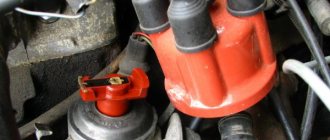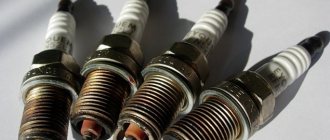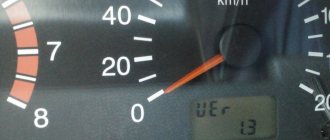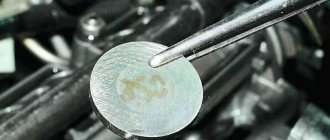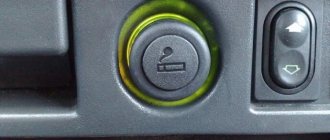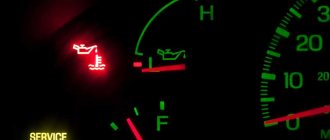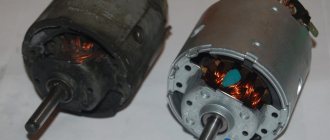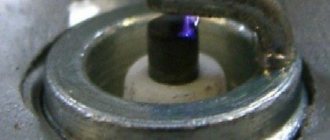Lack of spark on the spark plugs is one of two basic faults most often found on cars (the second is no fuel supply to the engine). Loss of spark or weak spark from the spark plugs indicates problems in the ignition system. Either in a high voltage circuit or a low voltage circuit. In this case, the car engine will not start at all (both cold and hot), or will start and stall (if there is a spark, but weak). Let's consider the main reasons for the loss of spark on carburetor engines of VAZ 2105, 2107, 2108, 2109, 21099 cars with contact and non-contact ignition systems.
Then we remove the central high-voltage wire, insert a working spark plug into its tip and place it on the engine (so that there is contact with ground). While the assistant turns the engine with the starter, you need to visually verify the absence or presence of a spark at the spark plug. A spark has appeared - the spark plugs themselves, the high-voltage wires or the ignition distributor in the distributor are faulty. There was still no spark - problems with the switch, Hall sensor, ignition coil.
Lost spark, reasons for contactless ignition system
- The ignition coil has failed.
Checking the ignition coil. The ignition coil is usually checked for winding resistance and insulation resistance using a tester. For oil-filled coils (27.3705) and dry coils (3122.3707), the resistance is slightly different. Read more: “Checking the ignition coil.” In the absence of a special device for testing, we use the method of replacing our coil with another one that is known to be good.
checking the primary winding of the ignition coil
- The switch is faulty.
Checked with an oscilloscope. Since not everyone has it, we use the replacement method - instead of our switch we install a known good one. You can very roughly estimate the performance of the switch based on the voltmeter readings after turning on the ignition (see “Checking the switch”).
- Hall sensor is faulty.
It is checked with a voltmeter according to a special connection diagram (see “Checking the Hall sensor”). If there is no voltmeter, we use the replacement method.
Hall sensor, check
- Open circuit in low voltage circuit.
Using the diagram, we look through the wires included in the ignition system, and if necessary, “ring” to detect a “break.” See "Contactless Ignition System Diagram".
In the contact ignition system, the list of malfunctions leading to the disappearance of the spark is as follows:
- The mechanical breaker in the distributor is faulty.
Its contacts have oxidized, collapsed or burned. There is no gap between the breaker contacts.
breaker contacts
- The ignition coil is faulty.
- "Open" in the low voltage circuit.
Notes and additions
— To quickly find the reason for the disappearance of the spark on the spark plugs, you need to know the principle of operation of both contact and non-contact ignition systems (for more details, see “The principle of operation of the ignition system”). The purpose of the ignition system is to generate high voltage current at the right moment and supply it to the spark plugs. This is accomplished by interrupting the low voltage current in the primary winding circuit of the ignition coil. In a contactless system, the switch interrupts the current based on a signal from the Hall sensor; in a contact system, a mechanical breaker with contacts is driven by a tetrahedron on the distributor shaft.
More articles on the ignition system of VAZ cars
Post by USA » 03 Dec 2011, 19:48
The spark went into the ground, dig deeper (c)
Why does the VAZ-2107 twitch - let’s understand the operation of the “distributor”
Well, if the engine of your VAZ-2107 suddenly stalls and does not start, we will find the reason and eliminate it quickly. Everyone knows that this happens if the “spark” disappears or there is no gasoline supplied at all. It’s much worse when the car seems to be moving, but the nerves are fraying - uneven idling, jerking and twitching when driving. Finding the root of the problem can take a lot of time and take a lot of money out of your pocket. And more often than not, these searches ultimately lead to a distributor. This material will help you correctly replace it with a working one, select a suitable replacement, and understand the device and operation.
Before delving into the “electrics”, it must be said that the reason for the “jerking” of the VAZ-2107 and other “classic” VAZ models may be an unsuccessful combination of the clutch driven disc damper and the elastic coupling of the driveshaft. Spare parts are supplied with parts whose characteristics may differ greatly from the factory ones, therefore, if the “jerking” intensifies after replacing the clutch or “soft connection”, you need to look for the cause there. Try installing a unit from another manufacturer - its characteristics will be different, the resonance in the transmission will disappear and the “jerking” will stop.
Stage one
Typically, the symptoms of the problem are as follows: the starter rotates properly in its standard mode, but the engine does not want to start. One of the most likely causes is a fuel pump that does not start. By the way, on injection “tens” it is submersible and is placed directly in the tank.
You can check the element by the presence of operating sound. Turn on the ignition - there should be a hum in the area of the rear seats. Sometimes he is missing. In this case, you should check the fuses. The VAZ-2110 is an injection car, and the fuse box is located on the side of the center console on the front passenger side. It is necessary to unscrew the fasteners, then remove the cover, check the fuses for functionality and, if necessary, replace them. If the elements are fully operational, then you need to check whether the relay will turn on, both the main one and the fuel pump. You can feel the moment of switching on with your finger. A characteristic click will also be heard.
If the fuel pump is operational, use a pressure gauge to check the presence of fuel in it. If there is no pressure gauge, then press the spool at the end of the fuel rail. This element may be contained in a protective cap. The pressure will be quite noticeable, although its power cannot be determined. A running pump and no pressure may indicate an obstruction in the fuel line. This may be caused by a clogged fuel filter.
What signs indicate a malfunction of the VAZ car distributor?
1. The engine does not start: - there is no gap or too large a gap between the breaker contacts; -burnt and dirty contacts; - the capacitor has failed; - the noise suppression resistance of the “slider” has burned out; - the distributor cover is “broken”; - the low voltage wire is broken or its terminals are oxidized; -Hall sensor burnt out (non-contact ignition). 2. The engine “shakes” at idle: - the gap between the contacts is not normal; - ignition too early. 3. The engine “jerks” at high speeds: - the gap between the breaker contacts is too large; - the spring of the movable contact of the breaker has weakened; - the springs of the centrifugal regulator have weakened. 4. “Jerking”, interruptions in all engine modes: -damage to high voltage wires, oxidized or loose in the sockets; -dirty, oily, burnt breaker contacts; - the corner of the moving contact in the distributor cover is worn out or broken; -cracks and burnouts of the “runner” and the distributor cover; - the capacitor is “half broken” and needs to be replaced; - the bushings are worn out and the distributor shaft is “playing”; - the contactless ignition system switch is faulty. 5. The car accelerates slowly, consumes a lot of fuel: -the ignition timing is incorrectly set. Note! Signs of a malfunction of the VAZ-2107 distributor are very easily confused with manifestations of malfunctions in the power system . Therefore, never start disassembling the distributor and carburetor with the fuel pump at the same time!
Distributor function in the ignition system of a carburetor car
The full name of this device “ignition switch-distributor” reveals part of its “responsibilities” - at a strictly defined time to break the low-voltage circuit of the ignition coil and distribute the resulting high-voltage energy, in a given order (1-3-4-2), among the cylinders . It is also “responsible” for changing the ignition timing depending on the speed of the engine crankshaft (crankshaft) using a centrifugal regulator and “correcting” this angle depending on the load on the engine using a vacuum corrector.
Ignition module and coil
Here you can check the error codes that are in the car's memory. If the ECU does not have a diagnostic function, you should install a known-good module.
You can find out why there is no spark on the VAZ-2110 (injector, 8 valves) by looking at the faulty controller. It is also possible that the wires from the controller to the ignition coil may break. If there is no spark on each of the coils, you should make sure there is power. If there is no electrical discharge for some reason, then the element must be replaced. The system has an ignition module. Therefore, a useful operation would be to check the “minus”.
Which distributor is suitable for the VAZ-2107
On all carburetor rear-wheel drive VAZ cars, the device has almost identical components and a similar operating principle. Distributors for engines with a volume of 1200-1300 cc differ in that: - the drive rod is 7 mm shorter; — no vacuum ignition timing regulator; — the settings of the weights and springs of the centrifugal regulator are different. For engines with a volume of 1500-1600 cc, all distributors are suitable in terms of mounting dimensions and characteristics. Only “Nivovskie” ones differ. They are tuned for stable traction at low speeds and the VAZ-2107 with such a distributor will accelerate slowly. The brands of “Nivovsky” distributors are: 3810.3706, 038.3706-10. And distributors of brands 0.3706 (contact) and 38.3706 (non-contact) are suitable for the “Seven” and other classic cars.
The starter turns, but does not start: diesel
The design of diesel cars differs from classic gasoline units. Here, ignition of the combustible mixture occurs according to a different principle, which imposes its own criteria for diagnosing the power plant.
Among the most common problems are the following. Lack of glow The most common problem is burnout of the glow plug electrode. Checking spark plugs is carried out exclusively using special equipment. Failure of one element causes tripping or popping noises during engine operation. If the parts themselves are functioning properly, the reason may be hidden in the armored wires or power relay.
Note! Part failure can occur while the car is moving. Due to the sufficient temperature of the combustion chamber, problems begin only after the block has cooled.
Incorrect fuel supply A common problem in winter is diesel freezing or waxing of filter elements. In this case, it is necessary to change the cleaning grids and warm up the machine in a warm box. If it happens in the summer, the search for the “root of evil” is done like this.
- Incorrect operation of anti-theft equipment - the alarm is turned off or repaired.
- The condition of the main pump and the integrity of the fuel lines are checked. If a hose or tube leaks, air may be sucked through the crack, causing a problem.
- The injectors are unscrewed from the internal combustion engine block and tested on special stands. Often the pressure hole becomes clogged after pouring low-quality fuel or driving over potholes - sediment rises from the bottom of the gas tank and enters the engine.
- If the starter turns, but the engine doesn’t even start (there is also no smoke from the exhaust pipe), it means that diesel fuel is not entering the cylinders at all. The first step is to check the serviceability of the high pressure fuel pump (HPF) and its drive pump.
- Next, all lines for each injector are diagnosed individually.
- Calibrating the diesel feed angle. The injection pump belt may jump or break, which will cause incorrect fluid injection.
The main components of the distributor and a description of its operation
VAZ classic distributor device
Device
The distributor is assembled in a housing. Inside it, a contact group is mounted on a bearing: moving and fixed contacts or a Hall sensor (for contactless ignition). To correct the advance angle, the vacuum regulator can rotate the contact group at a small angle relative to the housing. The capacitor is attached to the bottom of the case with screws. A drive roller is mounted on bushings in the center of the body. Its bottom has splines with which it engages with the drive gear. In the upper part of the roller there are contact drive cams (for contact ignition) or a steel cup with four slots - a screen (for contactless ignition). At the very top, on a steel platform, two weights and two springs of the centrifugal ignition regulator are installed. A plastic housing with a moving contact and noise suppression resistance of the high voltage distributor (slider) is screwed onto the top with two screws. The entire structure is closed with a lid on two spring latches. The body and cover have a tongue and groove so that they fit together in only one position. The cover contains contact terminals for high voltage wires from the spark plugs and from the ignition coil. The distributor is secured to the engine block using a stud, nut and pressure washer. To adjust the ignition timing, the housing can be rotated relative to the block.
Job
The distributor is connected through the drive to the engine crankshaft and rotates with it. For two full revolutions of the crankshaft, the distributor shaft makes one revolution. This is due to the fact that our engine is four-stroke. When installing the distributor in place, the roller is oriented in strict accordance with the operating order of the engine. This is done so that the contacts open and the spark jumps on the spark plug when the piston of each cylinder, compressing the combustible mixture, does not reach top dead center (TDC) by a few millimeters. This is called ignition advance. When the number of revolutions increases, the distance must be increased, and when it decreases, it must be decreased, which is what the centrifugal regulator does. Its weights, under the influence of centrifugal force, which is greater the higher the engine speed, diverge to the sides and move the cams relative to the roller, making ignition “earlier.” When the engine speed decreases, the springs return the weights to their place and the ignition becomes “later”. This is necessary to increase engine power and efficiency. In addition to the centrifugal one, a vacuum ignition timing regulator is also installed on the distributor. Its function is to fire “earlier” at low throttle opening angles and “later” at sharp throttle opening angles. At idle and at full throttle, the vacuum seal does not work. The regulators are adjusted only at the stands, so there is no need to change the settings yourself.
Possible reasons for absence
Most modern cars are equipped with many sensors. They make the life of the car owner easier and complicate repairs. In the electronics responsible for the operation of an injection engine, there are several sensors responsible for the spark formation process. But the reasons that there is no spark (VAZ-2110, injector, 8 valves) may also lie in other components. There are several types of possible breakdowns. The first includes various problems in the car’s fuel system. This includes malfunctions in which fuel cannot enter the cylinders or the supply is interrupted.
If there is no spark (VAZ-2110, injector, 8 valves), then this may be due to the fuel system. Often the pump relay or the submersible element itself fails. The test is performed by ear.
Then there are problems related to the electrical part. These are some of the most common faults. In case of such breakdowns, no electric discharge reaches the spark plug. Naturally, the mixture will not be set on fire. Global problems include complete engine failure and timing belt breakage. It is not worth dwelling on these malfunctions in detail.
Removal and installation of distributor VAZ-2107, 2104, 2105, 2106
Preparation
Before installing a new VAZ-2107 distributor for a contact ignition system, you need to adjust the gap between the contacts of the breaker. It is more convenient to do this with the device removed from the car. We check the gap with a flat feeler gauge. The value is set from 0.35 to 0.45 mm. In this case, the protrusion of the cam should move the moving contact away from the stationary contact as much as possible. We adjust by slightly loosening the screws, and then tighten them more firmly and check the gap again. Contacts that have worked hard may have a protrusion on one and a depression on the other, which interferes with adjustment. You can get around this problem by grinding off the protrusion with a needle file. It is better not to use sandpaper, because... small particles of abrasive will definitely “eat” into the surface and interfere with the operation of the contacts.
Diagnostics
To understand which part of the starter the breakdown occurred in, you should thoroughly clean it. First, the solenoid relay is checked. If it is working properly, a loud click will be heard. Another evidence of the serviceability of this mechanism is that the bendix moves slightly forward. The absence of a click indicates that the relay is broken and needs to be replaced with a new one.
If the problem is not in this part, then you need to make sure that all the insulation is in good condition. All damage can be restored with impregnating varnish and then checked with special electrical measuring instruments.
When, after a complete inspection, all parts are found to be in good condition, the rotor insulation must be checked. Traces of burning and soot on the anchor indicate that this device needs to be replaced. The collector must be clean, free of deposits, and if this defect is present, you can clean the element with sandpaper. After all procedures, the coupling is checked. It should spin freely in one direction and be locked in the other.
Checking the ignition timing of the VAZ-2107 engine
The methods described below make it possible to independently adjust the ignition timing. They are suitable equally well for both contact and non-contact distributors. We adjust the ignition timing at idle speed . We warm up the engine to operating temperature, at idle speed, turning the body relative to the block, “catch” the position in which the speed will be the highest. We fix the distributor in this position. We check the correct setting of the ignition timing “on the fly”. Having looked at a free section of a flat road, we drive out onto it.
We keep the speed at 40 km/h in fourth gear and sharply press the gas pedal. a loud metallic knock should be heard under the hood, disappearing by itself after a few (four to six) seconds. Is everything exactly like this for you? This means the adjustment is complete. If the knocking does not go away for a long time, we stop, loosen the distributor and turn the distributor clockwise a couple of millimeters, making the ignition later. We start the engine again, accelerate, and repeat the test. If there is no knocking at all, then the distributor needs to be turned counterclockwise, setting the ignition “early” and checked again while driving. After doing these steps several times, you get the optimal ignition timing specifically for your VAZ engine. Still have questions? Watch this video
What to do if there is no spark at the injector? Possible problems
In principle, in theory there are no particular difficulties in repairs of this kind. Despite this, it often causes difficulties in implementation for inexperienced motorists. To solve these, you need to act in the order described above, but if something doesn’t work out, it’s better to turn to professionals at a service station. This approach to repairs will not only save time, but also guarantee trouble-free operation of the car in the future.
Perhaps this concludes the most important information on today’s issue. We hope that the material presented was useful to you and provided answers to your questions. Good luck in operating and maintaining your car!
